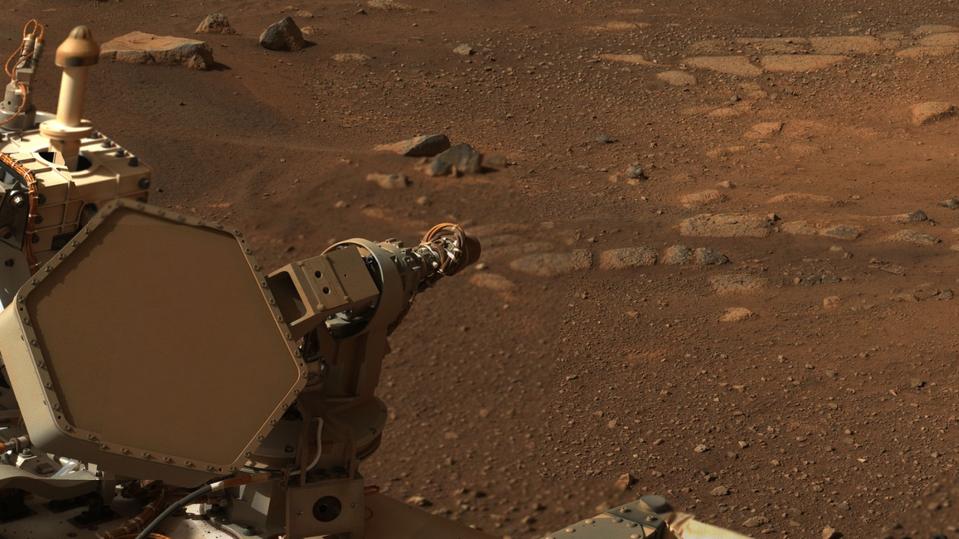The verdict is in – and NASA’s Perseverance rover is a hit.
Having touched down on Mars in the Jezero Crater last week on Thursday, February 18, this plucky robotic explorer has captured the hearts and minds of the world.
Following its dramatic descent to the surface, complete with stunning first-of-its-kind footage, we also learned about a mysterious message in its parachute.
Now that the rover is on the surface, however, it is already busy getting to work, using its camera to take images of its surroundings.
And yesterday, Wednesday, February 24, NASA released the first 360-degree panorama from the rover’s Mastcam-Z instrument, situated at the top of the rover’s neck, called its mast.
You can view the image right here.

The level of detail in the panorama is pretty astounding.
It was made using 142 images from the camera, revealed details on the crater rim and the nearby ancient river delta that Perseverance will study for signs of past life on Mars.
The image is zoomable, allowing you to take a detailed look at Perseverance’s immediate location on Mars, where it will spend another week or so.
The camera is able to see objects as small as 0.1 to 0.2 inches (3 to 5 millimeters) near the rover, and 6.5 to 10 feet (2 to 3 meters) in the distance.

The rim of Jezero Crater seen in the distance.
This was the rover’s second panorama, after a previous one captured by its Navigation Cameras – or Navcams, also located on the Mast, said NASA.
But it was the first high-definition panorama from the rover, with Mastcam-Z having a higher resolution than the Navcams.
This allowed the rover to spot some intriguing features, such as a “wind-carved rock” located nearby that looked particularly interesting.
“We’re nestled right in a sweet spot, where you can see different features similar in many ways to features found by Spirit, Opportunity, and Curiosity at their landing sites,” Jim Bell from Arizona State University’s School of Earth and Space Exploration, the lead on the Mastcam-Z instrument, said in a statement.

The rover spotted an odd rock nearby, carved by Martian wind.
The rover will continue running through some checks in the forthcoming days, perhaps taking its first drive relatively soon.
Then, in March, it will drive to a nearby location to deploy a helicopter on the surface, called Ingenuity, to perform the first attempt at flight on another world.
After that, the main science mission can begin, with the rover beginning its studies of the surface to look for evidence of fossilised Martian microbial life.
It’s a two-Earth-year mission that will also see the rover monitor the Martian weather, attempt to turn carbon dioxide into oxygen, and look for water-ice under the surface.
So, for the time being, you can maybe forgive it for taking a moment to relax at its landing site and bask in its Martian surroundings.
Thankfully, we get to do the same thanks to its cameras. If you want to pore through more images from the rover, you can do so right here.
https://news.google.com/__i/rss/rd/articles/CBMihAFodHRwczovL3d3dy5mb3JiZXMuY29tL3NpdGVzL2pvbmF0aGFub2NhbGxhZ2hhbi8yMDIxLzAyLzI1L2NoZWNrLW91dC10aGlzLWFtYXppbmctaGQtcGFub3JhbWEtb2YtbWFycy1mcm9tLW5hc2FzLXBlcnNldmVyYW5jZS1yb3Zlci_SAYgBaHR0cHM6Ly93d3cuZm9yYmVzLmNvbS9zaXRlcy9qb25hdGhhbm9jYWxsYWdoYW4vMjAyMS8wMi8yNS9jaGVjay1vdXQtdGhpcy1hbWF6aW5nLWhkLXBhbm9yYW1hLW9mLW1hcnMtZnJvbS1uYXNhcy1wZXJzZXZlcmFuY2Utcm92ZXIvYW1wLw?oc=5
2021-02-25 12:15:44Z
52781402488479
Tidak ada komentar:
Posting Komentar